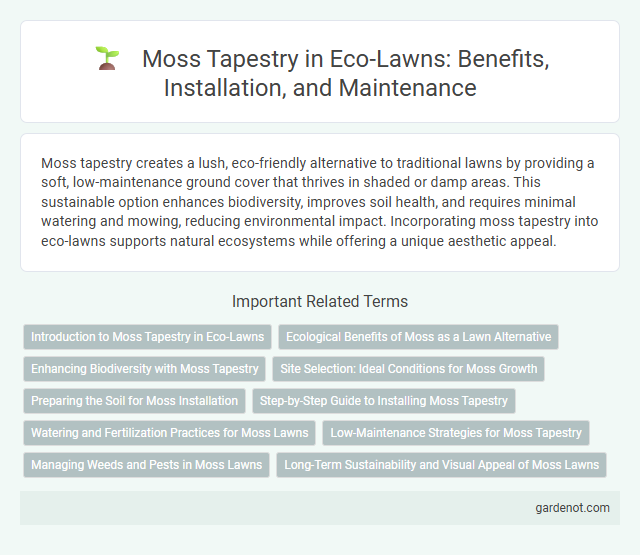Moss tapestry creates a lush, eco-friendly alternative to traditional lawns by providing a soft, low-maintenance ground cover that thrives in shaded or damp areas. This sustainable option enhances biodiversity, improves soil health, and requires minimal watering and mowing, reducing environmental impact. Incorporating moss tapestry into eco-lawns supports natural ecosystems while offering a unique aesthetic appeal.
Introduction to Moss Tapestry in Eco-Lawns
Moss tapestry in eco-lawns offers a sustainable ground cover that thrives in shaded, low-maintenance environments, requiring minimal water and no chemical fertilizers. This natural green carpet enhances soil health by preventing erosion and supporting biodiversity through its dense, moisture-retentive structure. Integrating moss tapestry into eco-lawns reduces carbon footprint while providing an aesthetically pleasing, eco-friendly alternative to traditional grass lawns.
Ecological Benefits of Moss as a Lawn Alternative
Moss tapestry provides superior ecological benefits as a lawn alternative by enhancing soil moisture retention and reducing the need for irrigation. Its natural capacity to absorb carbon dioxide contributes to improved air quality and carbon sequestration. Moss lawns require no pesticides or fertilizers, promoting biodiversity and supporting local ecosystems.
Enhancing Biodiversity with Moss Tapestry
Moss tapestry fosters enhanced biodiversity by creating a rich microhabitat that supports various insects, fungi, and small wildlife species. It improves soil health through natural moisture retention and nutrient cycling, promoting a balanced ecosystem. Integrating moss tapestry in eco-lawns helps establish resilient green spaces that contribute to urban biodiversity and environmental sustainability.
Site Selection: Ideal Conditions for Moss Growth
Moss tapestry thrives best in shaded, moist environments with acidic to neutral soil pH ranging from 5.0 to 6.5. Sites featuring consistent humidity, minimal foot traffic, and well-draining substrates enhance moss establishment and growth. Optimal conditions include locations protected from direct sunlight and strong winds, ensuring lush, vibrant moss coverage for eco-lawns.
Preparing the Soil for Moss Installation
Preparing the soil for moss installation requires assessing moisture levels and ensuring acidic pH between 5.0 and 6.0 to promote moss growth. Removing debris, compacting the soil lightly, and creating a smooth, shaded surface enhances moss adherence and vitality. Incorporating organic matter like peat moss improves soil texture and water retention critical for a thriving moss tapestry.
Step-by-Step Guide to Installing Moss Tapestry
Installing a moss tapestry begins with selecting a shaded, moist area where moss naturally thrives, ensuring optimal growth conditions. Prepare the surface by removing debris, loosening the soil, and lightly scoring it to help moss attach firmly. Press the moss pieces onto the soil, mist regularly to maintain humidity, and avoid foot traffic to encourage successful establishment and a lush, green tapestry.
Watering and Fertilization Practices for Moss Lawns
Moss lawns require minimal watering compared to traditional grass, thriving in consistently moist but well-drained conditions that prevent waterlogging and promote healthy growth. Fertilization for moss lawns involves using low-nitrogen, phosphorus-rich supplements to enhance moss vitality without encouraging algae or weed proliferation. Regular monitoring of soil pH and moisture levels ensures optimal nutrient absorption and supports a dense, vibrant moss tapestry.
Low-Maintenance Strategies for Moss Tapestry
Moss tapestry thrives in shady, moist environments with minimal soil disturbance, making it ideal for low-maintenance landscapes. Regularly monitoring soil moisture and avoiding heavy foot traffic reduce moss stress and encourage dense, lush growth without the need for fertilizers or mowing. Incorporating moss species adapted to local conditions further enhances durability and decreases upkeep requirements in eco-lawns.
Managing Weeds and Pests in Moss Lawns
Managing weeds and pests in moss lawns requires targeted strategies to preserve the delicate moss ecosystem. Regularly removing invasive weeds by hand prevents competition for nutrients and moisture, while encouraging healthy moss growth. Natural pest control methods, such as introducing beneficial insects and avoiding chemical herbicides, maintain the lawn's ecological balance and enhance its sustainability.
Long-Term Sustainability and Visual Appeal of Moss Lawns
Moss tapestry offers long-term sustainability by requiring minimal water, fertilizer, and mowing, significantly reducing environmental impact compared to traditional grass lawns. Its dense, green texture provides year-round visual appeal, maintaining vibrant color and softness even in shaded or damp areas where grass typically struggles. This low-maintenance ground cover supports biodiversity and soil health, making moss lawns a resilient and eco-friendly alternative for sustainable landscaping.
Moss tapestry Infographic

 gardenot.com
gardenot.com